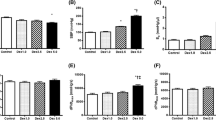Summary
We compared the oxygen cost of increasing ventricular contractility using Emax (slope of the ventricular end-systolic pressure-volume relation) as the index of ventricular contractility. Contractility was enhanced by calcium and epinephrine in paired experiments on dog left ventricles. Firstly, we obtained left ventricular oxygen consumption (Vo2) and systolic pressure-volume area (PVA, a measure of total mechanical energy) of contractions at different volumes in the control contractile state to determine a reference Vo2-PVA relation. PVA was obtained as the area in the pressure-volume (P-V) diagram which was bounded by the end-systolic P-V line, end-diastolic P-V curve and systolic P-V trajectory of individual contractions. Secondly, we gradually enhanced Emax with calcium and epinephrine in two consecutive runs at a fixed ventricular volume. Both Vo2 and PVA increased with enhanced Emax. From these Vo2-PVA data, we calculated the PVA-independent Vo2 values at the respective enhanced Emax levels and determined the oxygen cost of Emax as the slope of the relation between the PVA-independent Vo2 and Emax. The cost per beat and per 100g was 0.00158ml O2/ (mmHg/ml) for calcium and 0.00166 ml O2/(mmHg/ml) for epinephrine on average, values not significantly different from each other (P < 0.05). We conclude that epinephrine and calcium have similar oxygen costs of contractility over a wide range of Emax despite their different pharmacological mechanisms of positive inotropism.
Similar content being viewed by others
References
Suga H (1990) Ventricular energetics. Physiol Rev 70:247–277
Suga H (1979) Total mechanical energy of a ventricle model and cardiac oxygen consumption. Am J Physiol 236:H498-H505
Suga H, Hisano R, Goto Y, Yamada O, Igarashi Y (1983) Effect of positive inotropic agents on the relation between oxygen consumption and systolic pressure volume area in canine left ventricle. Circ Res 53:306–318
Burkhoff D, Yue DT, Oikawa RY, Franz MR, Schaefer J, Sagawa K (1987) Influence of ventricular contractility on non-work-related myocardial oxygen consumption. Heart Vessels 3:66–72
Suga H, Sagawa K, Shoukas AA (1973) Load independence of the instantaneous pressure-volume ratio of the canine left ventricle and effects of epinephrine and heart rate on the ratio. Circ Res 32:314–322
Futaki S, Nozawa T, Yasumura Y, Tanaka N, Suga H (1988) A new cardiotonic agent, OPC-8212, elevates the myocardial oxygen consumption versus pressure-volume area (PVA) relation in a similar manner to catecholamines and calcium in canine hearts. Heart Vessels 4:153–161
Ohgoshi Y, Goto Y, Futaki S, Yaku H, Suga H (1991) Sensitivities of cardiac O2 consumption and contractility to catecholamines in dogs. Am J Physiol 261:H196-H205
Wu D, Yasumura Y, Nozawa T, Tanaka N, Futaki S, Ohgoshi Y, Yaku H, Suga H (1989) Effect of ouabain on the relation between left ventricular oxygen consumption and systolic pressure-volume area (PVA) in dog heart. Heart Vessels 5:17–24
Ohgoshi Y, Goto Y, Futaki S, Yaku H, Kawaguchi O, Suga H (1990) New method to determine oxygen cost for contractility. Jpn J Physiol 40:127–138
Suga H, Futaki S, Ohgoshi Y, Yaku H, Goto Y (1989) Arteriovenous oximeter for O2 content difference, O2 saturations, and hemoglobin content. Am J Physiol 257:H1712-H1716
Suga H, Igarashi Y, Yamada O, Goto Y (1986) Cardiac oxygen consumption and systolic pressure volume area. Basic Res Cardiol 81 (Suppl 1):39–50
Suga H, Hayashi T, Suehiro S, Hisano R, Shirahata M, Ninomiya I (1981) Equal oxygen consumption rates of isovolumic and ejecting contractions with equal systolic pressure-volume areas in canine left ventricle. Circ Res 49:1082–1091
Ohgoshi Y, Goto Y, Futaki S, Yaku H, Kawaguchi K, Suga H (1991) Increased oxygen cost of contractility in stunned myocardium of dog. Circ Res 69:975–988
Kurihara S, Konishi M (1987) Effects of β-adrenoceptor stimulation on intracellular Ca transients and tension in rat ventricular muscle. Pflugers Arch 409:427–437
Rüegg JC (1987) Dependence of cardiac contractility on myofibrillar calcium sensitivity. NIPS 2:179–182
Tada M, Inui M (1983) Regulation of calcium transport by the ATPase-phospholamban system. J Mol Cell Cardiol 15:565–575
Winegrad S (1986) Membrane control of force generation. In: Fozzard HA, Haber E, Jennings RB, Katz AM, Morgan HE (eds) The heart and cardiovascular system, vol. 1. Raven, New York, pp 703–730
Chapman JB (1983) Heat production. In: Drake-Holland AJ, Noble MIM (eds) Cardiac Metabolism. Wiley, Chichester, pp 239–256
Gibbs CL, Loiselle DS, Wendt IR (1988) Activation heat in rabbit cardiac muscle. J Physiol (London) 395:115–130
Klocke FJ, Branunwald E, Ross J (1966) Oxygen cost of electrical activation of the heart. Circ Res 18:357–365
Langer GA (1974) Ionic movements and the control of contraction. In: Langer GA, Brady AJ (eds) Mammalian Myocardium. Wiley, New York, pp 193–217
Gibbs CL, Wendt IR (1987) Transducing chemical energy into mechanical function: A comparative view. Adv Exp Med Biol 222:153–162
Klocke FJ, Kaiser GA, Ross J, Braunwald E (1965) Mechanism of increase of myocardial oxygen uptake produced by catecholamines. Am J Physiol 209:913–918
Nozawa T, Yasumura Y, Futaki S, Tanaka N, Suga H (1988) No significant increase in O2 consumption of KCl-arrested dog heart with filling and dobutamine. Am J Physiol 255:H807-H812
Gibbs CL, Kotsanas G (1986) Factors regulating basal metabolism of the isolated perfused rabbit heart. Am J Physiol 250:998–1007
Mullins LJ (1989) Role of Na-Ca exchange in heart. In: Physiology and pathophysiology of the heart. Kluwer Academic, Boston, pp 241–251
Yasumura Y, Nozawa T, Futaki S, Tanaka N, Suga H (1989) Minor preload dependence of O2 consumption of unloaded contraction in dog heart. Am J Physiol 256:H1289-H1294
Yanagida T, Arata T, Oosawa F (1985) Sliding distance of actin filament induced by a myosin crossbridge during one ATP hydrolysis cycle. Nature 316:366–369
Author information
Authors and Affiliations
Rights and permissions
About this article
Cite this article
Ohgoshi, Y., Goto, Y., Kawaguchi, O. et al. Epinephrine and calcium have similar oxygen costs of contractility. Heart Vessels 7, 123–132 (1992). https://doi.org/10.1007/BF01744865
Received:
Revised:
Accepted:
Issue Date:
DOI: https://doi.org/10.1007/BF01744865




